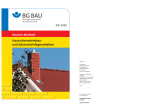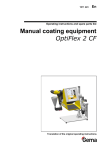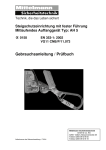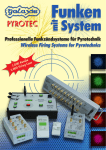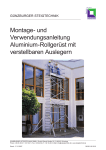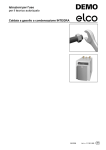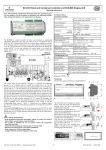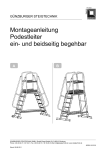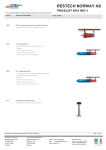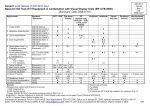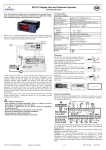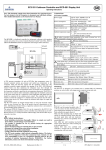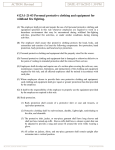Download Information Leaflet and Use Instructions
Transcript
Information Leaflet and Use Instructions Edition 2011 This Information Leaflet and the Use Instructions are to be used only in conjunction with the Information Leaflet and the Assembly and Use Instructions for the ZARGES ZAST arrester system (290922). ZAST Optiflex Slide Mechanism GB Nº 291325 If you need further information or, in the case of special requirements not adequately described in this Information Leaflet and the Use Instructions, please contact the manufacturer (see section 1.2). We also would like to point out that the contents of this Information Leaflet and the Use Instructions are not part of an earlier agreement, promise or a legally binding relation or that they should change these. All obligations arise from the relevant sales contract, which also contains the complete and only valid Conditions of Warranty (see also section 2.2). These contractual warranty conditions are neither expanded nor restricted by this Information Leaflet and the Use Instructions. The distribution and reproduction of this document and the utilisation and disclosure of its contents are allowed only with the express approval of the manufacturer. Any violations contravening the aforementioned statements will require payment of damages. Technical changes regarding the ZAST Optiflex slide mechanism may not have been included in this Information Leaflet and the Use Instructions. For more information, please contact the manufacturer. GB -2- Nº 291325 TABLE OF CONTENTS Seite 1 GENERAL INFORMATION ............................................................................... 4 1.1 1.2 1.3 1.4 1.5 1.6 1.6.1 Introduction ........................................................................................................ Manufacturer ..................................................................................................... Homologation .................................................................................................... Use Instructions Date of Issue .......................................................................... Copyright ........................................................................................................... Personnel Requirements .................................................................................. User Personnel .................................................................................................. 4 4 5 5 6 6 6 2 SAFETY RULES ............................................................................................... 6 2.1 2.2 2.3 2.4 2.5 2.6 Basic Safety Instructions ................................................................................... 6 Duties, Liability and Warranty ........................................................................... 7 Intended Use ..................................................................................................... 9 Improper Use ..................................................................................................... 9 Special Operator’s Duties ................................................................................. 9 Safety Installations .......................................................................................... 10 3 DESCRIPTION ................................................................................................ 10 3.1 3.1.1 3.2 3.3 3.4 Specifications .................................................................................................. System Performance Characteristics .............................................................. Slide Mechanism Specification Plates ............................................................ Description of Slide Mechanism ..................................................................... Accessories ..................................................................................................... 5 USING THE ARRESTER SYSTEM ................................................................. 15 5.1 5.2 5.2.1 5.2.2 Safety Rules and Warnings ............................................................................ Operating the Armature ................................................................................... Entering the Arrester System .......................................................................... Leaving the Arrester System ........................................................................... 6 MAINTENANCE AND STORAGE .................................................................. 18 6.1 6.2 6.3 6.4 Maintenance ................................................................................................... Storage ............................................................................................................ Transport ......................................................................................................... Packaging ....................................................................................................... 7 RESCUE OPERATIONS ................................................................................. 20 10 11 12 12 14 15 17 17 18 18 20 20 20 8 TESTS ............................................................................................................. 21 8.1 8.2 At Initial Start-up .............................................................................................. 21 Daily Checks ................................................................................................... 21 Nº 291325 -3- GB 1 GENERAL INFORMATION 1.1 Introduction The underlying Use Instructions apply only to the ZAST Optiflex slide mechanism intended as indicated in section 1.3. It is valid only in conjunction with the Assembly and Use Instructions for the ZARGES ZAST arrester system (290922). It is the responsibility of the operator to: • • ensure that local, regional and national regulations are observed, observe the rules (legislation, regulations, guidelines, etc.) in these Use Instructions for safe handling, ensure that the Information Leaflet and Use Instructions are made available to the assembling and operating personnel and that the information, notes, precautions and safety rules are observed in all aspects. • • Make sure that the user has read and understood the Safety Rules and Warnings before using the ZAST Optiflex slide mechanism. For further information, he should contact the responsible supervisor. • All safety regulations provided by the Assembly and Use Instructions for the ZARGES ZAST arrester system (290922) must be strictly adhered to. • It is not allowed to manipulate any of the system components. In case a defect has been detected, the slide mechanism and its connecting hardware should not be used. 1.2 Manufacturer The manufacturer of the ZAST Optiflex slide mechanism described in this documentation is ZARGES GmbH Sparte Steigtechnik - Schachttechnik/Steigleitern PO Box 16 30 Phone: 08 81/68 71 04 Fax: 08 81/68 73 72 Email: [email protected] Internet: http://www.zarges.de 82360 Weilheim GB -4- Nº 291325 1.3 Homologation The EC type approval of the slide mechanism described below was performed at the Institut für Arbeitssicherheit - BGIA Alte Heerstraße 111 53754 Sankt Augustin. The inspection of the slide mechanism described below is performed by the Institut für Arbeitssicherheit - BGIA Alte Heerstraße 111 53754 Sankt Augustin under the ID 0121. The ZAST Optiflex slide mechanism meets the EN 353-1 standard and is provided with the label. 1.4 Use Instructions Date of Issue The date of issue of these assembly and use instructions in German is MARCH 01, 2011. Nº 291325 -5- GB 1.5 Copyright • The copyright for these Use Instructions remains with the manufacturer. • Furthermore, all rights are reserved, in particular in the case of granted patents and utility-model patents. • Any violations of the aforementioned statements will require payment of damages. 1.6 Personnel Requirements 1.6.1 User The users of the slide mechanism have to be familiar with the slide mechanism and the arrester system. The user must be physically capable of climbing the ladder system using the arrester system. 2 SAFETY RULES 2.1 Basic Safety Instructions In Germany, the assembly and use of the arrester systems and the one-beam ladder is governed by the regulations listed below. In all other countries, the prevailing national regulations apply. • BGV A1 “Allgemeine Vorschriften” • BGV C22 “Bauarbeiten” • BGV C5 “Abwassertechnische Anlagen” • BGV D36 “Leitern und Tritte” • BGG 906 “Grundsätze für Auswahl, Ausbildung und Befähigungsnachweis von Sachkundigen für persönliche Schutzausrüstungen gegen Absturz” GB -6- Nº 291325 • BGI 530 “Hochbauarbeiten” booklet • BGR 177 “Sicherheitsregeln für Steigeisen und Steigeisengänge” • BGI 691 “Regeln für das Nachrüsten von Steigeisen- und Steigeisengängen mit Steigschutzeinrichtungen an Schornsteinen” • BGR 198 “Regeln für den Einsatz von persönlichen Schutzausrüstungen gegen Absturz”. Regulations may differ according to the application site. Be sure to follow them. 2.2 Duties, Liability and Warranty Knowing the safety instructions and the safety rules is a basic condition for the safe handling and problem-free operation of the ZAST Optiflex slide mechanism within the ZAST arrester system. These use instructions, in particular the safety instructions, should be followed by all persons when using the slide mechanism. Furthermore, the accident prevention rules and regulations applying at the work site must be observed. Hazards when using the ZAST Optiflex slide mechanism: • The slide mechanism is built according to the state of the art and recognised safety rules. Nevertheless, danger for life and limb of the user and third parties or damage to the slide mechanism, the ZAST arrester system or other properties can occur. The slide mechanism may only be used —> for the intended application and —> in a perfectly safe condition. Malfunctions affecting safety must be remedied immediately. Nº 291325 -7- GB Warranty and Liability The scope and period of warranty are stated in the sales and delivery conditions of the manufacturer. For any warranty claims based on deficiencies in the documentation, the Use Instructions valid at the time of delivery shall apply (see section 1.4). The following applies beyond the scope of the sales and warranty conditions: No liability shall be assumed for damage to persons and property which has occurred due to one or more of the following reasons: • any applications for which the slide mechanism was not intended, • improper use of the slide mechanism, • using the slide mechanism with defective safety installations or improperly affixed or defective protective devices, • ignorance or non-observance of these Use Instructions, • insufficiently qualified or instructed operating personnel, • improperly performed repairs, • use of non-genuine spare parts, • unauthorised constructive changes on the slide mechanism, • insufficient monitoring of components that are subject to wear and tear, • catastrophes caused by foreign objects and/or acts of providence. The operator/owner must ensure that • that the safety rules in accordance with section 2 et sqq. are observed, • that any improper use (see section 2.4) and any prohibited application are excluded and • • that an intended utilisation (see section 2.3) is guaranteed and that the slide mechanism is used in accordance with the contractually agreed operating instructions. GB -8- Nº 291325 2.3 Intended Use The ZAST Optiflex slide mechanism described in these use instructions is part of the personal safety equipment and may be used only for climbing on buildings, towers and shafts by persons in conjunction with the ZAST arrester system. You can detach and attach the slide mechanism at any point of the rack system within the insertion and removal points. The slide mechanism may be used on vertical rails only. Intended use also implies: • observance of all guidelines mentioned in these Use Instructions, and • performing the required security checks. 2.4 Improper Use An improper use, i.e. any deviation from the information on the slide mechanism described in section 2.3 of these Use Instructions, is an improper use in the sense of GPSG (German Equipment and Product Safety Act, last updated May 01, 2004). This also applies to the non-observance of the standards and directives mentioned in these Assembly and Use Instructions. Improper use may lead to hazardous situations. In this sense, improper use is, for example, using the personal safety equipment for carrying loads. The ZAST Optiflex slide mechanism may not be used on arrester systems with a swivel plate and horizontal arrester rails. 2.5 Special Operator’s Duties According to BGR 198, every operator has to create instructions for the use of the personal safety equipment, which have to be made available to the users. Moreover, the operator has to instruct the users on the basis of the operating instructions at least once a year. The slide mechanism, which is part of the personal safety equipment, comes with a time card according to DIN EN 365. The operator is responsible for the ownership and storage of the time card. Any missing specifications on the time card need to be filled in by the operator using a ballpoint or felt-tip pen immediately after receipt of the slide mechanism. Nº 291325 -9- GB 2.6 Safety Installations The slide mechanism, together with its shackles, the energy-absorbing band element and the spring hook, must be checked for condition and operability prior to each use. Any manipulation of the above-mentioned components is prohibited. In case a defect is detected, the slide mechanism and its connecting hardware should not be used. 3 DESCRIPTION 3.1 Specifications Weights: ZAST Optiflex slide mechanism w/ connecting hardware - aluminium and stainless steel .................................................... approx. 1.0 kg GB - 10 - Nº 291325 3.1.1 System Performance Characteristics 1 Figure 1 shows the performance characteristics of the arrester system with the ZAST Optiflex slide mechanism. The slide mechanism may only be used in ZAST-type vertical ZARGES arrester systems. 2 3 The EC Type Approval resulted in the following performance characteristics for the arrester system: Max. braking force Fmax and Catching range H WARNING = 5.95 kN = 0.57 m. The catching mechanism of the arrester system works only up to a specific range from the ground. For the ZAST-type ZARGES arrester system, the calculation of the performance characteristics and the free range required for a person to keep hanging after a fall, results in a 3.0 m danger zone. 3.0 m danger zone Figure 1 w/o scale Nº 291325 - 11 - GB 3.2 Slide Mechanism Specification Plates The type plates are attached to the cheeks of the slide mechanism. Figure 1.1 1 2 3 Space for conformity label Read information leaflet Ordering data 3.3 Description of Slide Mechanism The slide mechanism (2) includes the following components: • • • • • Guide rollers (2/1) for frictionless guidance (4 items) Armature (2/9) Shackle (2/2), stainless steel Energy-absorbing band element (2/3), AT1/2 model Aluminium spring hook (2/4) according to DIN EN 362 w/ dual safety lock and onehand action, AXK10 model) The armature has cheeks and hooks made of aluminum and inner parts made of stainless steel. GB - 12 - Nº 291325 The armature can be extended and arrested in the respective position in order to enter and/or leave the ZAST arrester system at any point. CAUTION It is important to enter and/or leave the system from a secure stand only (a platform or the like). On the left-hand cheek, there is an unlocking lever (2/5) which must be pushed in order to extend the armature. The armature must be placed upside down when extending, so that the gravity locking device (2/6) blocks the centre bolt (2/7). The armature stays in this position and can be placed on the arrester rail, for example. The gravity locking device is unlocked by extending (pulling) the components. When the armature is kept upside down, the unlocking function is disabled. The armature parts snap together by the force of the spring within the connecting bolt and are automatically locked by the unlocking lever. 8 1 9 Press 10 5 2 3 6 7 4 Figure 2 Nº 291325 - 13 - GB The armature has four locking functionalities: • • • • It is normally closed. Opening is possible only when the unlocking lever is pushed. The armature cannot be opened when standing upside down. The armature cannot be closed when standing upside down. The armature is provided with a forced insertion, i.e. the right cheek (2/8) is flattened. Only the flattened cheek (2/10) can be moved past the fixed base of the detachable and the fixed rail stops. The left cheek, however, is round (not flattened) and serves as a stop when the rail stop is guided in the wrong direction. The direction of the arrow on the label (1/1) indicates the guiding direction of the armature. When moving in the vertical direction, i.e. from bottom to top or vice versa, the guide (arrow) must always show up. Horizontal movements may not be performed with this armature. The energy-absorbing band element (2/3) consists of a folded plastic band sealed within a plastic bag. The slide mechanism is part of the personal safety equipment. 3.4 Accessories The accessories available include a catching belt (3) according to EN 361. The belt has an arrester eyelet at the front end. Model No. 47524 CAUTION Only the arrester eyelet (3/1) (belly attachment) may be used for hooking the slide mechanism. 1 Figure 3 GB - 14 - Nº 291325 5 USING THE ARRESTER SYSTEM 5.1 Safety Rules • The personal safety equipment for the user includes the slide mechanism with shackle, energy-absorbing band element and spring hook. Each user is responsible for the personal safety equipment when using it. He or she assumes full responsibility for its functionality. • The slide mechanism may only be used for climbing with the ZAST-type ZARGES arrester system. It is not allowed to use third-party components. • The user must visually inspect the ZAST-type arrester system before entering it. If there are any defects detected during the visual inspection, they must be eliminated by qualified personnel before using the system. • Unauthorised constructive changes on the components of the slide mechanism are prohibited and lead to the exclusion of warranty and liability. • Only use slide mechanisms which have been inspected by the prescribed inspection date. • The user should wear a catching belt according to EN 361 with an arrester eyelet. For further information about putting on and attaching the catching belt at the slide mechanism, refer to the catching belt user manual. • Any components which may have been stressed by a fall need to be removed and sent to the manufacturer for inspection and/or repair. A deployed energyabsorbing band element may NOT be used with the slide mechanism. • The user climbing the arrester system has to be physically fit and not be under the influence of alcohol, drugs or medication. • For storing and cleaning the slide mechanism, refer to section 6. • Be sure to hook the catching belt arrester eyelet directly (i.e. without a rope or the like) in the slide mechanism. • Use only natural drying methods if the energy-absorbing band element has become humid or wet during use or cleaning. No direct sunlight, fire or other heat sources are allowed. Nº 291325 - 15 - GB • Check more regularly if the energy-absorbing band element has been exposed to extreme temperatures. • The slide mechanism may not be used on arrester systems with a swivel plate and horizontal arrester rails. WARNINGS • The spring hook may only be attached to the centre arrester eyelet (belly attachment) of the catching belt. It is not allowed to hook into side holding eyelets or eyelets at the front area which may be installed at the hip and/or breast area of the belt. • It is not allowed to climb using any safety belts, seat belts or older type B catching belts which only partially go around the body. • Climbing is only allowed with a closed catching device, i.e. using a spring hook which is properly closed. • Refer to the performance characteristics of the ZAST-type arrester system and, in particular, note that the arrester system has no protective effect at heights below 3m (measured from the ground). • Furthermore, there is no protective effect if the catching device is exposed to a continuous horizontal force during ascension. Consequently, the user is not allowed to ascend or descend freehand. • If in doubt about the safe condition of the facility, have a qualified person inspect it. In case the system has been stressed by a fall, replace the system, in any case, the armature. Check the rail system for damage. The moving parts of the armature should never be lubricated, as they could easily resinify. Inaccessible parts such as the gravity locking device should be cleaned with compressed air. GB - 16 - Nº 291325 5.2 Operating the Armature 5.2.1 Entering the Arrester System CAUTION 1 • Hold the armature in the guiding direction (see label), then push the unlocking lever (4/2), extend and hold the armature. • Place the armature upside down, so that the gravity locking device (4/1) locks the centre bolt. • Hook the slide mechanism spring hook onto the catching belt arrester eyelet and secure the spring hook. • From a secure stand, hold the armature over the arrester rail in the guiding direction. • Extend the armature. The gravity locking device falls back into its initial position and the spring force closes the armature. The user must hold the armature so as to allow the cheeks to engage into the arrester rail. • Extend to check if the armature is locked. The armature is locked when the colour mark on the centre connecting bolt (5/1) is visible and the bolt overlaps the cheek by approx. 5 mm. CAUTION Nº 291325 2 Perform all activities from a secure stand when entering the ZAST arrester system. Figure 4 1 Press Figure 5 The ZAST arrester system may not be climbed with the armature unlocked. Make sure to check both the armature and the ZAST arrester system. Do not enter the system unless the defects have been eliminated. - 17 - GB 5.2.2 Leaving the ZAST arrester system CAUTION Perform all activities from a secure stand when leaving the ZAST arrester system. • Push the unlocking lever (4/1), then extend and hold the armature. • Detach the armature from the arrester rail. • Place the armature upside down so that the gravity locking device (4/2) locks the centre bolt. • Extend the armature. The gravity locking device will fall back into its initial position and spring force close the armature. • Unhook the spring hook from the catching belt arrester eyelet. 6 MAINTENANCE AND STORAGE 6.1 Maintenance • All slide mechanism components are maintenance-free. • Remove any dirt from the slide mechanism after each use. • Clean the energy-absorbing band element with a small amount of water mixed with a small amount of sensitive-fabrics detergent. Never use any other cleaning agents like gasoline, acetone, thinner, etc. • Use only natural drying methods if the energy-absorbing band element. No direct sunlight, fire or other heat sources are allowed. • Before and after each use, make sure to check the slide mechanism’s catch and the relateed spring clip for proper condition and ease of movement. • Before and after each use, make sure to check the mechanism of the gravity locking device, the unlocking lever and the connecting bolt for proper operation. The inspection should be according to the activities described in section 5.2.1 and 5.2.2. GB - 18 - Nº 291325 • If the energy-absorbing band element needs to be replaced, please contact ZARGES-Steigtechnik. If the energy-absorbing band element is to be replaced by the user’s experts/qualified personnel of, the shackle bolt should be secured with LOCTITE 2701. Make sure to note the replacement in the inspection book. CAUTION Any components which may have been stressed by a fall need to be removed and sent to the manufacturer for inspection and/or repair. • The energy-absorbing band element must be replaced every 6 years. Should any doubts concerning the operational reliability of the energy-absorbing band element arise during the annual checks, the energy-absorbing band element should be replaced. Make sure to note the replacement in the inspection book. • Check more regularly if the energy-absorbing band element has been exposed to extreme temperatures. • You are not allowed to disassemble the armature. This work should be done by qualified personnel only. We recommend letting ZARGES-Steigtechnik perform this work. The moving parts of the armature should never be lubricated, as they could easily resinify. Inaccessible parts such as the gravity locking device should be cleaned with compressed air! • Making the guiding rollers easy-to-move: NOTES First, try to clean the guiding rollers with compressed air and a brush. Loosen the guiding roller bolts with a 3 mm Allen key. Clean rollers and bolts with a suitable detergent. All parts must be dry and grease-free before installing them. Apply a drop of Loctite 2701 onto the hole thread and screw in the bolts with rollers. Remove any remaining Loctite 2701. Replace any rollers in accordance with Service-Pack 2 800429. Replace any shackle, spring hook or band element in accordance with Service-Pack 1 800428. Nº 291325 - 19 - GB 6.2 • Storage Make sure the slide mechanism with the energy-absorbing band element is stored in such a way that: - any impact of aggressive materials (acid, oil, etc.) - temperatures of 60 °C or more - temperatures below -10 °C - direct light and UV radiation - humidity are excluded. • We recommend to choose a storage location that is not too warm. 6.3 • Transport The user must carry the slide mechanism in a container which protects it from external influences (weather, mechanical damage, etc.) during transport. 6.4 • Packaging The slide mechanism must be kept in a moisture repellent packaging for storage and transport. Refer to section 6.2 and 6.3. 7 RESCUE OPERATIONS • The operator and/or the user must schedule and determine measures for rescue of the arrester system user prior to its use. For example, a second person may be used as an observer. • Do not allow any long hanging times after a fall. GB - 20 - Nº 291325 8 TESTS 8.1 At Initial Start-up After a check, the operator must fill out the supplied time card. 8.2 Daily Checks • Daily before each use, the user must check the slide mechanism with its connecting hardware for proper condition. • Check both sides of the type plates with the safety instructions for damage. • Check the retaining rings at the slide mechanism connecting bolts for condition and tightness, replace if necessary. • Check guide rollers for proper condition and ease of movement. • The gravity locking device bolt must move easily within the guide. • Check the functionality and ease of movement of the unlocking lever. • Check the spring tension within the connecting bolts. The armature should close automatically after unlocking. • Check the following function: Unlock and extend the armature, tilt it 180° and allow the unlocking device to snap back. The bolt should not close by itself. Again, tilt the armature by 180°, unlock and allow the unlocking device to snap back again. The armature should close automatically. The bolt cone must be visible. • The operator is responsible for having a qualified person check the personal safety equipment of the slide mechanism as needed by operational requirements, in any case at least once a year. • The inspection results and the resulting measures have to be documented. ZARGES recommends keeping an inspection book in which all the data pertaining to the arrester system are entered. This inspection book also contains instructions for the performance of the inspection and its documentation. The inspection book is available from ZARGES GmbH - Abteilung Schachttechnik/ Steigleitern. Nº 291325 - 21 - GB EC Declaration of Conformity in the sense of EC Directive 89/686/EEC, Annex II A (Personal Safety Equipments) modified by Directives 93/ 68/EEC, 93/95/EEC und 96/58/EC The ZAST Optiflex type ZARGES slide mechanism, No. 47588, has been designed and built according to the aforementioned EC directives, in the sole responsibility of ZARGES GmbH Sparte Steigtechnik - Schachttechnik/Steigleitern Postfach 16 30 82360 Weilheim The following harmonized standards apply: DIN EN 353 Part 1:2002 -- Personal safety equipment for protection against falling; arrester systems with fixed guide DIN EN 362:1993 -- Personal safety equipment for protection against falling; Connecting elements DIN EN 363:2002 -- Personal safety equipment for protection against falling; catching elements DIN EN 365:1993 -- Personal safety equipment for protection against falling; general requirements for user manuals and identification The notified authority for monitoring the ZAST Optiflex slide mechanism is: Institut für Arbeitssicherheit - BGIA Alte Heerstraße 111 53754 Sankt Augustin under the ID 0121 and is involved for Storing the documentation according to Annex VI of EC Directive 89/392/EEC Inspecting for proper application of the harmonized standards with confirmation of the correct documentation according to Annex VI of EC Directive 89/392/EEC EC Type Approval, Certificate No. BGIA 021048 of March 30, 2009 ............................................................ (Olav Beck), Product Manager, March 30, 2009 GB - 22 - Nº 291325 Complete catalogue of the basic safety and health requirements and the harmonizing standards or other technical specifications taken into account for the PPE design: (according to Annex II 89/686/EEC) Section according to Annex II 89/686/EEC List of Requirements Specified Section of the Requirements 1.1 Design Principles 4.1 DIN EN 353-1:2002 1.1.1 Ergonomics 5.1 DIN EN 363:2002 1.1.2 Protection Level und Protection Class 4.3, 4.5 DIN EN 353-1:2002 1.1.2.1 Highest Protection Level available 1.2 Innocuousness of the PPE 1.2.1 Hazardous nature and interfering effects of the PPE 4.1, 4.2 DIN EN 353-1:2002 1.2.1.1 Suitable Basic Materials 4.2 DIN EN 353-1:2002 1.2.1.2 Appropriate surface condition of each PPE part that comes into contact with the user 4.1, 5.1 DIN EN 353-1:2002 2.4 PPE exposed to aging 4.2, 4.6, 6 DIN EN 353-1:2002 3.1 Protection against mechanical shocks 3.1.1 Shock by falling or flung-out objects and by the impact of a part of the human body on an obstacle 4.5 DIN EN 353-1:2002 3.1.2 Falling accidents 4.5 DIN EN 353-1:2002 3.1.2.2 Prevention of falling from heights 4.5 DIN EN 353-1:2002 Nº 291325 - 23 - GB
























